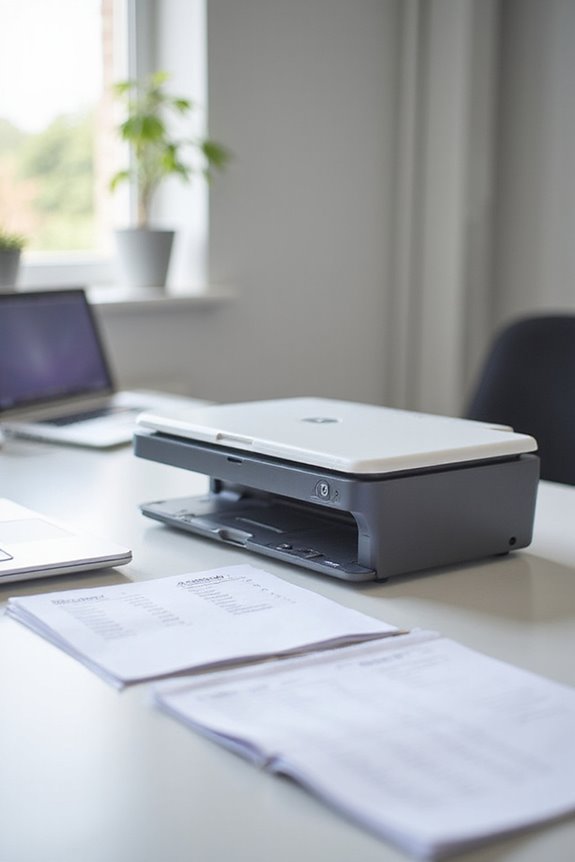To efficiently use a scanner for tax preparation, we should choose the right type, like an ADF scanner for speed and duplex features. Before scanning, we’ll sort and clean documents, removing fasteners. Set the scanner to 300 dpi for clarity and save in PDF format. After scanning, organizing files with a consistent naming convention helps retrieval. Implement version control and security features to protect our information. If we want to enhance our process even further, there’s more to explore.
Key Takeaways
- Sort and categorize your tax documents by type and importance before scanning to ensure nothing is missed.
- Use a scanner set to 300 dpi to capture clear and detailed images of your documents.
- Opt for PDF format when scanning for easy storage and compliance with tax submission standards.
- Review scanned files for clarity and completeness, re-scanning any blurry or incomplete images as needed.
- Organize digital files with a consistent naming convention and hierarchical folders for efficient retrieval during tax preparation.
Types of Scanners for Tax Preparation
When it comes to preparing taxes, having the right scanner can make a significant difference in efficiency and accuracy. We often find ourselves comparing different scanner types to suit our needs best. Flatbed scanners excel with high-resolution outputs, making them perfect for delicate documents but require manual handling and are slower. On the other hand, Automatic Document Feed (ADF) scanners offer high-speed scanning, processing up to 60 pages per minute while handling various paper types with ease. Portable scanners provide convenience for on-the-go scanning, ideal for occasional use. Finally, all-in-one devices save space but may not handle heavy loads efficiently. Each scanner features unique strengths that cater to our tax preparation workflow, helping us stay organized and effective. Additionally, selecting a scanner with built-in OCR technology can enhance document management by allowing easy conversion into searchable formats.
Preparing Documents for Scanning
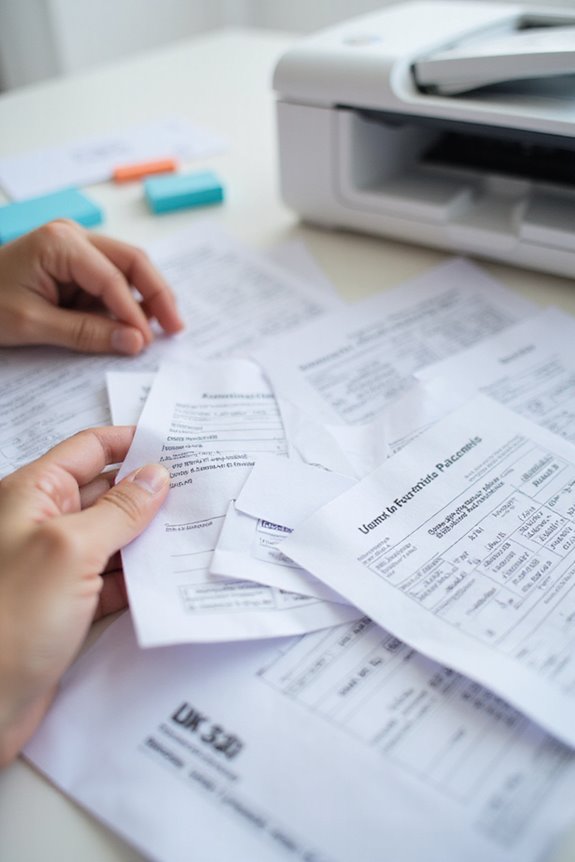
Preparing documents for scanning is an important step in streamlining our tax preparation process. We should start with document sorting, categorizing them by type and importance to guarantee nothing gets overlooked. Next, let’s remove any fasteners like staples and paper clips, as they can cause damage during scanning. We’ll align all documents properly to avoid misalignment and take a moment to clean them, removing dust and debris that could affect scan quality. It’s also vital to verify we have all necessary documents in order. Personal information, income documents, investment statements, and other income records should be grouped for easier access. Additionally, using a scanner that offers scanning speeds can significantly enhance our efficiency during the scanning process. This careful preparation paves the way for a smooth scanning experience and efficient organization in our digital files.
Scanning Process for Tax Documents
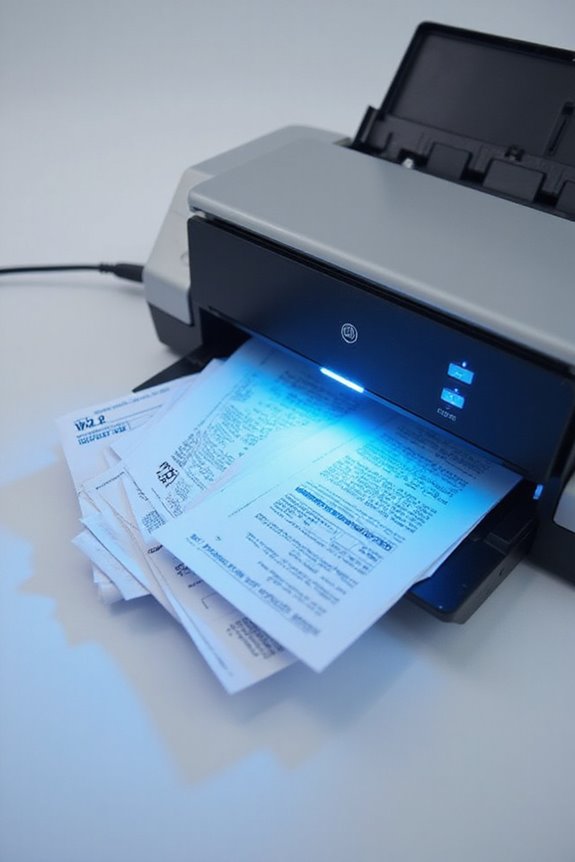
To guarantee efficient tax document management, we must focus on the scanning process itself. First, we need to set our scanner resolution to 300 dpi for clear and accurate images. It’s best to scan documents directly into PDF format, which meets tax submission standards. If we have double-sided forms, choosing duplex scanning makes things easier. We should also scan in black and white to save storage space, unless color is absolutely necessary. Before scanning, let’s verify all pages are flat and free of staples. After scanning, we should quickly review files for clarity and completeness. If any images are blurry, it’s vital to re-scan them to maintain high-quality records. Additionally, using a scanner with duplex scanning capability can significantly speed up the process of handling double-sided documents.
Organizing and Managing Digital Tax Documents
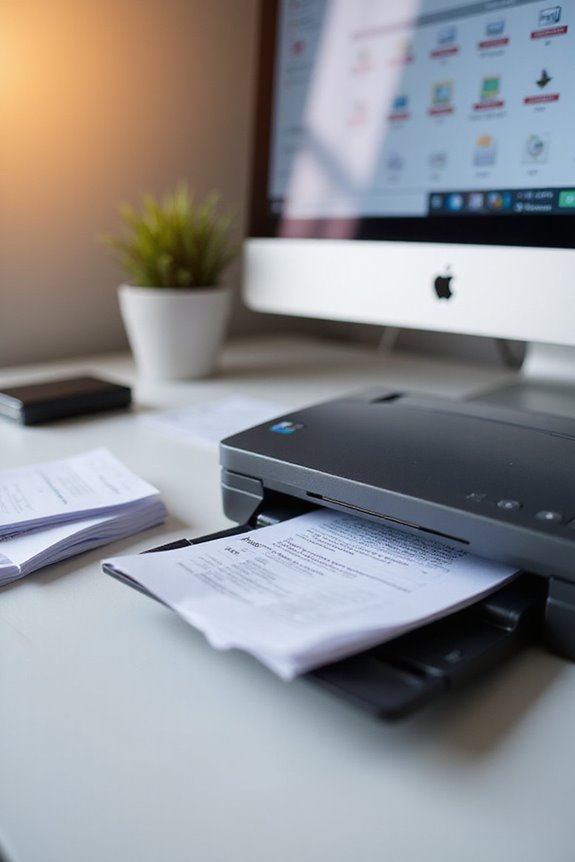
Organizing and managing our digital tax documents can make the tax preparation process immensely smoother. First, we should establish a uniform naming convention, like YYYY-MM-DD_TaxType_ClientName, to guarantee consistent file identification. Creating a hierarchical folder structure segmented by year and document type improves our digital filing effectiveness. By applying version control in filenames, we can efficiently track document updates and changes. Utilizing metadata tags enhances document indexing, making retrieval faster and easier. Securing our files with encryption and role-based access keeps sensitive information safe. Regular backups and proper storage solutions protect our documents against loss. By following these practices, we streamline access to important information, ultimately leading to effective tax preparation. Additionally, choosing a scanner with high optical resolution can significantly improve the accuracy of our scanned documents.
Best Practices and Tips for Scanner Use in Tax Prep
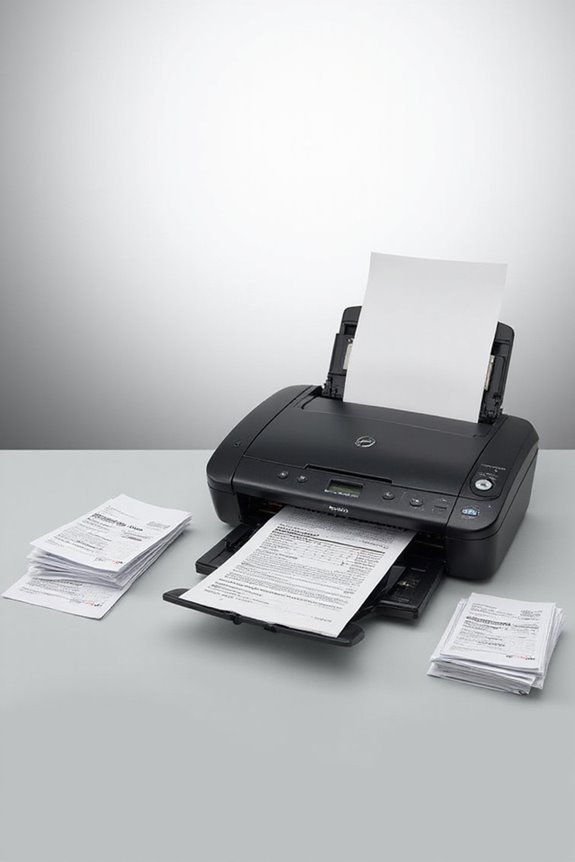
While scanning documents might seem straightforward, employing best practices can greatly enhance our tax preparation efficiency. We should use PDF for our scanned files to guarantee easy handling. Setting our scanner to 300 dpi strikes a balance between clarity and manageable file size. When scanning, let’s opt for black and white to improve text legibility and reduce file weight. Remember, scanning original documents preserves accuracy, and scanning one document per page keeps things organized. Remember to keep up with scanner maintenance to avoid image quality issues. After scanning, we can utilize file compression tools to save space without sacrificing quality. By following these tips, we’ll streamline our tax prep and foster better organization throughout the process. Additionally, ensuring duplex scanning efficiency can significantly reduce the time spent on high-volume tasks, making the tax preparation process even smoother.
Frequently Asked Questions
What Types of Documents Should I Not Scan for Tax Preparation?
When preparing for taxes, we shouldn’t scan original signatures or non-essential receipts. Keeping original legal documents secure is vital, as is avoiding potential risks posed by digital sharing of sensitive information.
Can I Use a Smartphone to Scan Tax Documents Effectively?
Yes, we can use smartphone scanning effectively for tax documents. With care, we guarantee document quality while benefiting from convenience and easy organization. Scanning apps enhance clarity, making digitization fast and manageable during tax preparation.
How Long Should I Retain Digital Tax Documents After Scanning?
We should retain digital tax documents at least as long as required by IRS guidelines, ensuring their document lifespan aligns with retention periods. This way, we safeguard our interests and stay compliant with digital retention requirements.
Is It Necessary to Keep Physical Copies After Digitizing?
Imagine we digitized our tax records last year. Since digital recordkeeping meets IRS standards, we won’t need to keep physical copies. It’s smart to focus on secure storage and proper tax document retention practices instead.
What Are the Risks of Inadequate Scanner Security Measures?
We must recognize that inadequate scanner security exposes us to scanner vulnerabilities, increasing the risk of data breaches. Protecting our sensitive information is essential to maintaining client trust and compliance with regulations.




